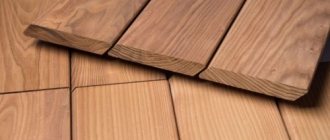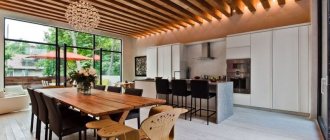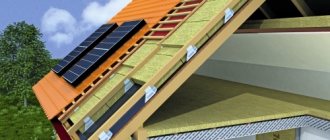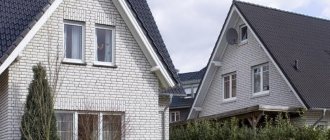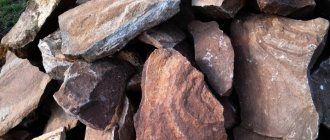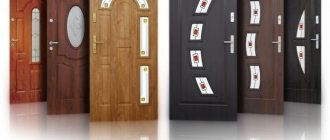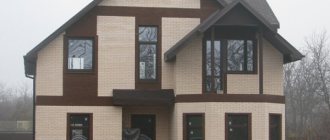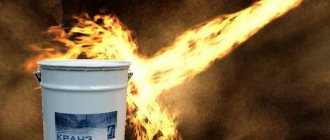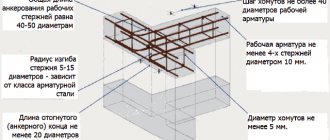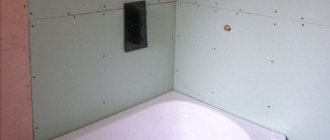Modern materials science has advanced quite noticeably with technology - there are truly revolutionary new building materials, new ways of constructing buildings are emerging. New synthetic building materials are being created that are lighter, stronger and more environmentally friendly than conventional ones. All this also stimulates new architecture - very different from what we are used to, plus, very safe for the environment.
When cement cracks, it is a much more serious problem than many people think. And it's not about aesthetics, which is certainly important. This is different: water will get into the crack and begin to undermine the concrete and reinforcement, which is always used for the strength of the structure. In an environment with changing temperatures, this problem is exacerbated by freeze-thaw action: the water in a crack expands when it freezes, pushing each side of the crack a little further apart. And then, when the ice thaws, the water will settle deeper, destroying further and making the crack deeper.
But what if concrete could heal itself? Or asphalt, or even metal? Billions of dollars could be saved in repair and restoration costs alone, not to mention the reduction in environmental damage.
Some innovative building materials will find their place, perhaps in small niches, and a number of new building materials have the prospect of becoming widely used. Buildings with traditional brick and concrete structures will gradually become a thing of the past, since the demand of humanity is obvious: we need environmentally friendly, energy efficient, durable and lightweight buildings that will look beautiful and functional.
We have collected the most interesting and impressive in their properties innovative materials in construction that are already being used, and building materials as a promising concept tested in pilot projects. A number of building materials are conditionally new - that is, the technology itself was developed and tested a long time ago, but is now used selectively and not everywhere. New building materials are used both in decorative finishing works and in full-fledged building structures as the main material.
So, modern materials for building a house, the top 15 most impressive
- transparent tree
- Carbon fiber
- SensiTiles
- Self-healing concrete
- Airgel
- Richlite
- Liquid granite
- Bendable, flexible concrete
- Concrete Canvas
- Transparent aluminum
- Solid wood
- Hydroceramics
- CABKOMA
- Flexicomb
- Ultra white paint
transparent tree
The creation of the latest ecological transparent wood material was reported back in 2016, but it was not until 2022 that the scientist who, with a team from the University of Maryland at College Park, invented a way to make wood transparent, announced that tests had been completed and a sustainable result had been obtained. Transparent wood is at least 5 times stronger and lighter than glass, and is also more thermally efficient. It is these characteristics that make it much more interesting than plastic. Other advantages include: the raw material is renewable and environmentally friendly: balsa wood grows quickly, in 5 years a mature tree is obtained, production costs are much lower than for glass production, where there is a significant carbon footprint due to heating and electricity costs.
Transparent wood is quite flexible as it contains natural cellulose.
To achieve transparency, balsa wood is soaked in a special solution, and then epoxy resin is added to the structure. Transparent wood or wood glass can be used instead of traditional double-glazed windows, or other elements in building structures where transparency, but also strength, as well as environmental friendliness and energy saving are required.
New panel materials for finishing walls and ceilings
The advent of frame finishing of interior spaces has made it possible to solve the issue of repairing old rooms with crooked walls at a completely new level. Instead of throwing tens of kilograms of cement-sand mass, to level the surface, a relatively simple technology is used for laying flat, glass-like gypsum plasterboards on a pre-mounted steel profile frame. With the help of new technology, it turned out to be possible to level and cover walls even with extremely curvature of the surface.
Along with plasterboard for finishing work, MDF boards made from pressed cellulose fibers began to be used. The outer surface of this material is covered with a laminated layer that imitates wood, stone, or tile. The new, lightweight and flexible material can be used to decorate ceilings and walls, simulating cladding made from expensive types of wood or natural stone.
A relatively new technology for finishing ceilings is the use of heat-shrinkable polyvinyl chloride membranes. To decorate the ceiling surface, it is enough to stretch a thin polymer sheet onto a pre-assembled frame and heat the surface with a heat gun. As a result of shrinkage, the membrane is leveled to a mirror state, hiding defects and problem areas of the ceiling.
Carbon fiber
Truly a material of the future and an innovative invention that is used in many areas where strength and lightness are required - and construction is the very industry where the demand for such qualities is of utmost importance. Carbon fiber is much lighter than iron (75%) and aluminum (30%). Carbon fiber is used to reinforce all traditional building materials, enhancing their strength - brick, reinforced concrete blocks, wooden structures, and also providing less thickness of panels and, accordingly, less weight. Carbon fiber reinforcement in reinforced concrete also provides excellent thermal insulation. The only negative that limits mass use is the high cost of the material.
Warm wall
Another innovation in the field of bricks is a block called “thermal wall”. It was invented in 1999. The thermal wall is presented in the form of a block, which consists of three layers. The first layer is a load-bearing block that carries the main load, the second is a layer of insulation, usually polystyrene, less often mineral wool, and the last is a decorative facade layer. The thermal conductivity of such a block is 6 times higher than that of ordinary brick. The heating wall is installed using tile adhesive, which is applied in a thin layer, which eliminates the appearance of efflorescence on the wall surface. This material has a large variety of configurations and design options. It is also possible to manufacture custom blocks. These blocks have no equal in thermal conductivity; they can retain both heat in winter and coolness in summer. Thermal walls can deservedly be called the material of the future, thanks to its efficiency, speed and ease of installation and a wide variety of facade design options.
SensiTiles - acrylic decorative tiles
New materials in construction
- not necessarily with innovative physical qualities in terms of strength and safety. These are also materials with technologies that serve for spectacular decoration and the implementation of the most extravagant architectural or design ideas. A new type of finishing building material is sensitive tiles with acrylic fiber, which literally reacts to your movements, touches, and light source changes. Optical fiber transmits light and reacts: the tile can flicker, be illuminated, capture and diffuse neighboring colors across its surface. Decorating with such material provides new opportunities in architecture and interior design.
The most popular new finishing methods
Traditionally, a wide range of materials for finishing a newly built building is divided into several large groups:
- Decorative materials for interior finishing work. This also includes floor and ceiling coverings, wall finishing materials for auxiliary premises;
- Facing and protective coatings used in finishing the facade of a building;
- Coverings for bedrooms and children's rooms;
- Universal materials based on ceramics, composites and plastics.
For your information!
Most new materials and coatings represent further technological developments of traditional finishing methods. Most manufacturers follow this approach to developing new materials for two reasons. Firstly, it is easier and faster to overcome a person’s psychological barrier to the perception of new materials. Secondly, a modified product is much easier to sell than a completely new product.
Traditionally, the development of new materials proceeds in three directions:
- Getting a new look. For example, most of today's new wallpapers have such a range of paints, patterns and colors that were previously simply technically unavailable for production;
- Improvement of old finishing characteristics. With the introduction of new technologies for the production of ceramics and porcelain stoneware, the design, quality and durability of floor and wall tiles have increased by an order of magnitude;
- Increasing the safety and environmental friendliness of coatings, especially for children, people suffering from allergies and intolerance to certain groups of chemical compounds. Demand for new, safer finishing options is growing much faster than for coatings with unusual appearance.
The bulk of new finishing materials have emerged through the widespread use of gypsum mixtures, acrylic and polyurethane resins, and the production of updated types of ceramics and compounds. Technologies producing materials for exterior decoration of houses have received the greatest development.
Self-healing concrete
If we literally translate the English version of “self healing concrete”, then it sounds like “self-healing concrete”, which, you see, hints at science fiction. Back in 2015, inventor Henk Jonkers from Delft University of Technology showed an innovative method for repairing cracks in concrete using... bacteria. The principle of the technology is simple: capsules with special bacteria and nutrients for them were added to the concrete, which were activated as soon as water entered. The cracked concrete was rebuilt with moisture and filled with limestone, which was produced by bacteria. In addition to this bio-technology, there is another alternative from Korean researchers, where capsules of a certain polymer are added to concrete. It also, under the influence of moisture and sun, begins to react - to swell and fill the crack.
Concrete is a very reliable and long-standing building material, but it loses its properties when cracked, so many materials scientists around the world are working on its modern upgrade.
There is recent evidence that American scientists from Worcester Polytechnic Institute (WPI) have also developed bioconcrete, which contains an enzyme that reacts with CO2, releasing calcium carbonate crystals - similar in characteristics to concrete. And thus all the cracks are filled, strengthening the betot. Millimeter cracks are restored within a day.
Another development by scientists from the University of Colorado is based on bacterial photosynthesis. The composition of bioconcrete includes a mixture of cyanobacteria - photosynthetic bacteria, gelatin and sand. They react to water and increase in size, filling cavities.
Dye
Various paints and varnishes are used to decorate walls. There are water-based and solvent-based formulations. The former are safe to use. The latter, after drying, form a fairly dense layer. When choosing, you should take into account the purpose of the room for which the finishing material is selected. For the hallway you will need paint with a good level of vapor permeability. For the kitchen, it is worth ordering a composition that forms a moisture-resistant coating.
The decorative characteristics of the formed coatings also differ. Manufacturers offer compositions that allow you to create a glossy or matte, smooth or embossed coating that helps hide small irregularities on the base.
Depending on the composition, paint is usually divided into:
- water-based, have an attractive price, a wide range of colors, and a mild chemical composition. The coating formed with their help is characterized by low resistance to abrasion and high humidity;
- acrylic, characterized by vapor permeability, but at the same time destroyed by water drops. It has become quite widespread. The coating retains its brightness when exposed to ultraviolet light. Can be used for finishing walls indoors. Retains brightness for 15–20 years. It takes a long time for the coating to dry;
- alkyd, which has a budget price and is easy to apply. The coating takes only one hour to dry. However, the formed coating will not last long. After a year, you will have to update the layer to restore the brightness. The material is toxic, but does not tolerate exposure to ultraviolet radiation. Alkyd paint is not suitable for decorating walls in the nursery and bedroom;
- silicate, which is based on liquid glass, mixed with a certain amount of coloring pigments and fillers. The formed coating resists moisture and temperature fluctuations well. Used to decorate walls in basements, balconies, verandas;
- silicone with a good level of vapor permeability and excellent dirt-repellent properties. The coating retains its integrity when exposed to water. Has sufficient strength. Vapor permeable. Has a long service life. Suitable for decorating the walls of the bathroom, kitchen, hallway. Helps level out unevenness on the surface of walls;
- oil, which is rarely used to decorate indoor walls due to the presence of harmful components in the composition. It takes a long time for the formed layer to dry. The coating is vapor-tight. May crack. However, their affordable price makes them in demand among consumers. They are practically not used for wall decoration. This is a suitable option for decorating a heating radiator, walls running along the wall.
5.Aerogel
The world's hardest and lightest material. Because it consists of 99.8% air!
A synthetic, porous, ultra-lightweight material is produced from a gel in which the liquid component of the gel is replaced by a gas. The result is a very hard body with extremely low density and low thermal conductivity. It feels like fragile polystyrene foam. Aerogels can be made from a variety of chemical compounds. It was first produced in 1931, the brainchild of Samuel Stevenson Kistler, who bet that he could replace a liquid with a gas without shrinking the structure itself. The first aerogels were obtained from silica gels. Kistler's later work involved aerogels based on alumina, chromium oxide and tin dioxide. Carbon aerogels were first developed in the late 1980s.
A special feature of aerogels is that they can have a thermal conductivity lower than that of the gas they contain. This material provides excellent thermal insulation, so it is widely used on an industrial scale for thermal insulation - environmentally friendly and effective. Due to the high and fine porosity of the structure, aerogels can be used as a collecting matrix for the smallest dust particles. (He is mentioned in the movie "Stardust")
The warmest brick
It would seem that it is simply impossible to improve brick - the market offers many options for this wall material for all occasions. But specialists from the Swiss research institute Empa were able to surprise us by combining ceramics and thermal insulation in one product. This is how the warmest brick in the world turned out - “Aerobriks”. Its cavities are filled with so-called airgel - a synthetic substance similar to light foam.
Thanks to this innovation, bricks resist cold 8 times better than regular bricks of the same size. In addition, it adequately withstands heating up to 300°C. Unfortunately, at the moment, Aerobrix is not widely used - it is too expensive. One square meter of wall costs about 30,000 rubles. But over time, the technology will become cheaper, becoming more accessible.
9
Richlite
Durable paper composite. It is created from waste paper and pressed into hard, smooth panels that can be processed. There is nothing to say about the environmental friendliness of paper - this is its main advantage. However, technology is turning it into an amazing raw material that is so needed for green construction.
Unlike stone or solid surface, Richlite performs just like dense hardwood and can be milled, sanded, routed and joined with ease. Richlite material is also waterproof, hygienic, has low moisture absorption, heat and fire resistance, and is extremely dense and durable. And its appearance is as natural and pleasant as possible. Therefore, it is used in many industries, and even for the production of musical instruments, where they replace expensive ebony, which provides a certain sound quality. So Richlite turned out to be a worthy analogue, affordable. In a word, it is a finishing material known and loved by many architects for the design of furniture, interior elements and creative structures.
Fresco
The walls can also be decorated with a fresco - do not think that this is a fashion of bygone days. The variety of textures, voluminous patterns and interesting styles is simply bound to please you. We recommend sticking to atypical colors, such as chocolate or emerald. Avoid overused pompous castles and gardens. And keep in mind that for the bathroom it is better to choose large textured tiles rather than a fresco.
Photo: leroymerlin.ru
Liquid granite
Artificial “liquid” stone, a special liquid construction mixture (70% marble chips and 30% special additives and decorative filler), which is sprayed onto a specific surface. Thanks to its composition, the liquid hardens beautifully and firmly, providing the surface with strength and a decorative appearance. Liquid granite is an environmentally friendly material because it contains safe resins and natural marble chips and mineral fillers. This composite material is actively used in finishing works, for the manufacture or coating of individual structures or interior elements.
New plaster and paint coatings
Decorative plaster based on acrylic resins and many different marble or calcite fillers made it possible not only to change the color and texture of the walls, but also to give them a new look by simulating natural stone or forming a certain surface relief. This coating practically does not fade in the sun, is not afraid of rain and frost, and if the application technology is followed, it can stay on the walls for more than ten years.
The disadvantages of plaster materials include the high dependence of the quality of new coatings on the qualifications of the plasterer; in addition, most of the work has to be done manually, especially at the stage of forming the texture of the walls.
Important! A real discovery in the field of finishing facade walls was the emergence of new water-soluble acrylic, water-based and water-dispersed paints, which have a colossal number of new shades and colors.
With their appearance, the outer walls and facade of the house can be painted in the most exquisite tones and colors. In the vast majority of cases, new paint and varnish materials for the exterior of the house made it possible to give old and gray concrete buildings a fresh, updated look with minimal effort.
Bendable, flexible concrete
Developments to improve the quality of concrete are among the most popular, and this is not surprising. In fact, all construction is based on concrete. We have already mentioned that one of the problems of concrete is its fragility if chips and cracks appear that form due to exposure to the external environment. Additionally, concrete may be strong, but it is fixed and load-limited. Back in 2014, Singaporeans were able to solve the issue of not only strength and weight reduction by eliminating reinforcement in concrete structures, but also added an uncharacteristic property of concrete - flexibility. Thanks to a unique additive, the new ConFlexPave concrete received flexibility and strength - 3 times higher than conventional concrete. The thinnest ultrafiber is mixed into the solution, which slides in the concrete structure without becoming fixed in it. This is what gives the effect of elasticity.
However, there is no limit to perfection. Many scientists continue to develop flexible concrete. Thus, specialists from Swinburne University created concrete without cement, but with the same outstanding characteristics in terms of flexibility and loads. The environmental friendliness of the new concrete is that it contains fly ash, a geopolymer composite - a typical waste product from coal-fired power plants. It hardens at room temperature, which means there is no need for high, environmentally friendly production costs. But most importantly, the new concrete is 400 times more flexible than conventional concrete, while maintaining the strength of concrete. Geopolymers not only add a bending coefficient, but also improve resistance to possible micro-fractures. Polymer fibers hold the structure under load even with cracks, so the new material can be used in seismically active areas - the risk of destruction of buildings made of such concrete is minimized.
Piles and beams constructed with closed cell insulation
Pile houses today are built mainly with hollow piles and beams. Meanwhile, this space can also be used for additional insulation of the foundation of the house, which allows you to achieve a higher R-value (thermal insulation).
A pile foundation insulated with insulators can solve many problems. In addition, massive piles and beams made from lumber at least 120 centimeters long will also allow you to build a stronger and more stable floor that will not sag, creak, or deteriorate as quickly from exposure to adverse weather conditions.
Piles and beams with closed cell insulation are the key to building highly durable houses; they are resistant to severe frost and floods. Closed cell insulation is far superior to fiberglass wadding and currently leads the industry in insulation cost.
Of course, for Russian developers, for whom every ruble counts, additional insulation of piles or foundation frames sometimes looks too expensive. However, in Western countries, where there are no alternatives to electric heating, and at the same time, electricity is much more expensive than here, this technology has already become in demand.
Concrete Canvas
Design solution using Concrete Canvas
It is essentially a concrete fabric in a roll - a revolutionary material that offers limitless design possibilities in building architecture and new challenges for construction.
The patented Concrete Canvas® solution is used for a wide range of construction applications and more. This allows you to build concrete structures with minimal installation costs and training of specialists. Installation is usually ten times faster: unroll the prepared roll and simply add water.
This is an auxiliary material that facilitates a number of works preceding the construction of structures, or is involved in the preparation of infrastructure facilities: canals, repair of coatings, protection of surfaces, slopes, strengthening of reservoirs and pipes.
Natural materials
Traditionally, finishing from natural materials was limited to laying wooden parquet and gluing standard paper wallpaper using adhesive solutions based on modified cellulose. The modern interpretation of environmentally friendly premises is increasingly forcing homeowners to abandon vinyl or non-woven wallpaper in favor of more exotic trellises made of cork, reed or woven bamboo fiber.
It is no secret that even new gypsum plaster mixtures contain surfactants, polymer plasticizers and dyes, so compound plaster materials based on finely ground silicon and lime are increasingly used to decorate the most important rooms in the house. The use of natural types of plaster is considered an absolute novelty, for example, Moroccan tadelakt - a waterproof coating without dyes and synthetic binders.
The most expensive type of finishing is the use of genuine leather and fabrics made of cotton, linen and jute.
10.Transparent aluminum
This material of the future is a physical reality. Simply put, it is a transparent ceramic based on aluminum oxynitride (AlON). The features of this material are scratch-resistant and durable, these characteristics are much higher than those of aluminosilicate glass (quartz), and 85% harder than sapphire. In addition, it can withstand heating up to 2100 C⁰. Resistant to radiation, acids, alkalis and water. Naturally, this material immediately went into service with the military and for optical production. But in construction, it is used to make impact-resistant windows, domes and other elements that require transparency and strength.
Coniferous panels
This material was born out of the trend towards environmentally friendly products. The raw material for it is compressed spruce needles. The adhesive resin contained in the needles acts as a binder. No other chemicals are used in production. The result is a sheet material that is used as a substrate for laminate and parquet boards.
The size of coniferous panels is 590 × 850 mm, the thickness can be 3-7 mm. They are laid diagonally on the floor, end-to-end, and secured with tape to prevent spreading.
Coniferous agglomerate retains heat well, but is not very durable. In addition, in a humid environment it can become moldy.
10
11.Solid laminated wood
This is a special technology that uses wood in all elements. The wood is enclosed in panels and laminated, making it a solid material that is much stronger than ordinary wood. There are categories such as cross-laminated timber and laminated timber. Laminated timber consists of several pieces of lumber glued together that are used to create strong beams. Cross-laminated timber is made from pieces of lumber laid in alternating directions to form large panels that can support heavy weight. Both types of wood are amazingly fire resistant. The outer layers, when burned, create a char that helps insulate the rest of the wood. In fire tests they have demonstrated the ability to maintain their structural integrity. Solid wood helps sequester carbon even as trees grow and retains this property already in buildings. According to one study published in the Journal of Sustainable Forestry, using sustainable forestry, 14 to 31% of global emissions could be prevented by replacing materials used in buildings and bridges with wood.
Wallpaper
Photo: Harlequin. To properly apply and use wallpaper, be sure to read the information on the label. The manufacturer indicates there the important properties of the wallpaper, how to clean the surface in case of contamination, where to apply the glue (on the canvas itself or on the wall), and sometimes even the gluing method. So, when applying a counter sticker, each second canvas is turned over relative to the previous one, changing direction
Photo: Harlequin. Wallpaper
Wallpaper is not just rolls of paper with a pattern, but the most interesting material for creating a unique interior. Today, manufacturers and designers do not offer ready-made solutions for wall decoration. They invite us to co-creation, play with space, color, texture, pattern, helping to realize the need for self-expression in decorating our own home. It is interesting that the release of one collection of paper, vinyl, non-woven, textile wallpaper lasts on average 3–4 years. But decorative canvases glued to walls can last 15–20 years. Of course, this is true for a harmonious interior that does not get boring, and the desire to change something in it rarely appears. An important role in the design of a room is played by integrated solutions, that is, collections consisting of several types of wallpaper, borders, decors and panels, as well as tulle and curtains.
Photo: Orthograf. Photo wallpaper in the form of a world map can become an original decoration for one of the living room walls
Photo: Sanderson
Photo: AS Creation
Photo: Marburg
Photo: Marburg
12.Hydroceramics (passive cooling)
Composite facade material made of clay and hydrogel, which is capable of cooling the interior of buildings to 6 C⁰. . Called Hydroceramic, the material uses hydrogel's ability to absorb 500 times its own weight in water to create a building system that "becomes a living being as part of nature rather than outside of it." It was developed by Spanish students back in 2014, and since then this material and technology of self-cooling systems have been in great demand in construction and architecture. Especially in green building: savings of up to 28% of the total energy consumption of traditional cooling devices.
Wood nails
The metal nail, known to us since ancient times, copes with its tasks perfectly. But it cannot be called an ideal. Problems arise when it is necessary to disassemble a wooden structure. You have to spend a lot of time and effort pulling out fasteners, which often bend and get stuck tightly. There is one more problem - iron nails are susceptible to corrosion. As they rust, they not only destroy themselves, weakening the connection, but also leave sloppy red spots on the surface of the board.
Beck Fastener Group's invention solves all problems at once. These are nails made of... wood, more precisely, solid beech. When disassembling a wooden structure, you do not need to pull them out - you can simply saw them or break them. And of course, there can be no talk of any corrosion.
Wooden nails are driven in using a pneumatic gun. No pre-drilling required
The fasteners, called LignoLoc, have a diameter of 3.7 mm and a length of 50 to 65 mm. It is worth noting that wooden nails are inferior in strength to metal nails. They cannot be used in capital construction. But they are great for interior decoration and can also be useful in making furniture.
8
CABKOMA - hydrocarbon threads, string support
For seismological areas like Japan, materials that can withstand earthquakes are very important. Therefore, Komatsu Seiten Fabric Laboratory developed a thermoplastic carbon fiber composite - CABKOMA Strand Rod. The composite is covered with inorganic and synthetic fibers, with a thermoplastic resin finish, to create the world's lightest seismic reinforcement system. The innovative thread-strings are almost five times lighter than metal wire of the same strength and are beautiful in design. In addition, they are quite efficient - the building meets the requirements for seismic reinforcement. Of course, like all carbon materials, the material is not cheap.
Smart glass
Continuing the “glass” theme, we’ll tell you about a development that allows you to make a transparent material opaque with one touch of your hand. This magical effect is achieved quite simply. A liquid crystal film is placed between two glass panels and electricity is passed through it. When energy is applied, the crystals change their course of movement, lining up perpendicular to the surface of the glass, and it becomes transparent. But as soon as the current is turned off, the particles resume Brownian motion, and the material becomes cloudy, becoming impenetrable to view.
Despite the presence of a conductive layer, smart glass can be used in rooms with a high degree of humidity
4
14.Flexicomb
Flexicomb - like a lamp
The borrowed honeycomb structure is embodied in the flexicomb material. A very simple idea turned out to be incredibly flexible and functional. The idea originated at Yale University, where they studied the structure of honeycombs. By combining drinking straws into one array, in essence, a structure resembling a honeycomb is obtained. Thousands of polypropylene tubes are tightly connected into a flexible matrix that can be molded into different shapes. This structure perfectly transmits light and is often used for the manufacture of decorative lighting elements.
Fake diamond
Photo: White Hills. In apartments and houses with fairly constant temperature and humidity, and most importantly, the absence of aggressive environmental influences, the conditions for covering surfaces with decorative artificial stone can be considered ideal
Photo: Evgeniy Kulibaba. The combination of artificial stone and living plants looks very picturesque
In interiors, decorative facing stone is increasingly replacing natural materials. Its expressive rough texture helps to design accent elements of houses and apartments - fireplace portals, niches, arches and window openings, entire walls or individual sections thereof. The main components of artificial stone are Portland cement (as a binding component), light fillers (expanded clay, perlite, pumice, quartz sand or mixtures thereof), mineral pigments and modified additives to obtain the necessary performance characteristics. Modern interiors are often eclectic, and the most interesting images are built on a combination of different textures. Stone decoration is especially expressive next to homogeneous surfaces - smooth walls, transparent glass, furniture of strict shapes.
Decorative facing brick
A popular type of artificial stone is decorative brick. The small weight of the “brick” cladding (up to 20 kg/m²) allows the material to be mounted on any wall base, including those lined with gypsum board or chipboard. Two types of elements are used for cladding: planar and angular. The rough, unpolished texture of natural or, conversely, rich, bright tones looks organically in interiors decorated in the style of minimalism and hi-tech. Lovers of antiquity will appreciate the walls made of bricks darkened by time with uneven edges.
Glass tiles
SolTech Energy from Sweden has developed a unique building material for roofing buildings - glass tiles. It is equipped with built-in photocells that accumulate solar energy and allow it to be used for various needs (water heating, heating, power grid operation).
These tiles are made from tempered impact-resistant glass, so they are not inferior in strength to traditional ceramic counterparts. The shape and size of individual glass elements correspond to the parameters of ceramic tiles, so they can be used to partially cover the roof. At the same time, maximum efficiency from its use is achieved on roofs facing the south side.
Linen insulation boards
Environmental friendliness is one of the main directions in the development of the latest technologies and materials in the construction industry, so boards made of pressed flax, impregnated with natural layers of boron, fit into this trend perfectly. They are moisture and fire resistant, do not support the development of fungi and mold and do not accumulate condensation, therefore they are suitable for use in conditions of high humidity (in bathhouses, under-roof and attic insulation structures).
Linen boards can provide high-quality thermal insulation for up to 75 years (for comparison: the service life of glass wool insulation is 15-25 years, and mineral wool insulation is up to 50 years).
Wall chaser
A wall chaser is the best tool for creating grooves for electrical wiring, water supply and heating systems. It is based on a pair of diamond discs. You can adjust the distance between them, and also set the depth of the groove. An important advantage of the wall chaser is the presence of a dust collector, which removes waste to the vacuum cleaner or to the side. The result of using such modern apartment renovation technologies is a minimum of waste and hassle.
